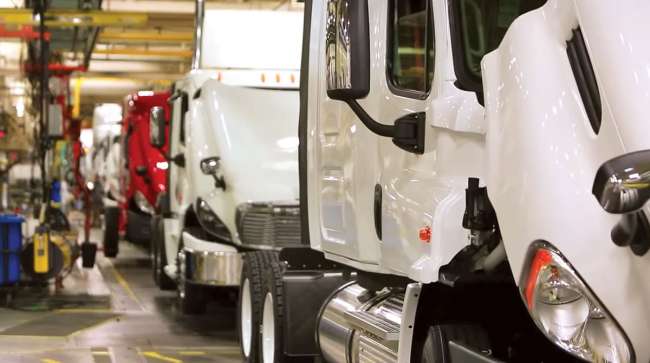Staff Reporter
Class 8 Truck Sales Reach 19,932 in January

[Stay on top of transportation news: Get TTNews in your inbox.]
U.S. Class 8 retail sales in January rose 34.2% year-over-year, Wards Intelligence reported.
Sales hit 19,932 compared with 14,857 a year earlier.
The latest sales figures came off a record high of 29,172 for December.
Freightliner, a brand of Daimler Truck North America, had the biggest market share with 9,409 trucks sold, accounting for 47.2% of all sales for the month. Peterbilt Motors Co., a Paccar Inc. brand, experienced the largest year-over-year increase in truck sales at 51.5% to 2,459 from 1,623.

Host Seth Clevenger speaks with autonomous vehicle pioneer Don Burnette about the pros and cons of driverless cars and trucks. Hear the program above and at RoadSigns.TTNews.com.
Third of a three-part series on autonomous vehicles. Hear Part I here, and Part II here.
Data showed that all seven of the major truck manufacturers experienced an increase in sales over the year.
Kenworth Truck Co., another Paccar Inc. brand, saw sales increased 17.9% year-over-year to 2,614 from 2,218. Navistar experienced a 26.1% increased in sales to 2,459 from 1,950 the prior year.
Mack Trucks’ sales rose 44.8% to 989 from 683, and Volvo Trucks North America’s sales increased slightly by 0.1% year-over-year to 1,405 from 1,404. Mack and VTNA are brands of Volvo Group. Western Star, a Daimler brand, experienced a 21.9% increase in sales to 567 from 465.
In addition to the major truck manufacturers, Tesla sold 30 trucks.
“It was a little bit better taking into consideration what we normally see,” ACT Research Vice President Steve Tam said. “At the end of the year, you get this big surge in production and sales as folks — at least those that have fiscal year-ends — try to hit those performance targets.
In spite of what seems to be a stumbling freight picture, higher financing costs, and increasingly restrictive credit availability, ACT continues to see healthy sales and build trends for Class 8 into 2023.https://t.co/1bSf55VuNw pic.twitter.com/eJgnF9D9XI
— ACT Research (@actresearch) February 14, 2023
“But the reality is, you just can’t get it all done. And so some of those retail sales transactions just don’t get completed in the December time frame.”
Tam noted the month-over-month drop usually has been 35% or 36% this time of year. But this time, the decrease fell short of that seasonal trend at 32%. He suspects manufacturers trying to clear their backlogs of uncompleted vehicles and more transactions than usual spilling over into the new year drove the stronger- than-usual outcome.

Tam
“We think the industry is in pretty good shape with respect to taking care of that issue,” Tam said. “We’re probably back to something that remotely resembles normal in terms of incomplete trucks, whatever normal is. The one thing that I don’t want to indicate is that means that our supply chain challenges are all resolved and everything is golden.”
Tam believes there has been a change in strategy coming from OEMs. He noted they have become more hesitant to even start production on a truck if they know they don’t have all the parts. Thus, they defer starting instead of storing unfinished trucks.

Kriete
“Unit increases [year-over-year] are so much more a reflection of the supply chain improvements than they are of market demand improvements,” said David Kriete, president of Kriete Truck Centers. “Demand in all segments remains pretty strong, but the supply of trucks via a strengthened supply chain is the real catalyst for improved unit counts between these time periods. Sales and demand of heavy-duty trucks is strong. Despite inflation, the order boards remain strong, and our customers continue to seek ways to replace or grow their fleets.”

Gomez
Robert Gomez, executive vice president of sales for Worldwide Equipment Enterprises, pointed out the distinction between when a vehicle is built versus when it can be registered and sold. He noted some trucks can have a quick turnaround while others have to wait months.
“If I have a T880 or the equivalent on the Peterbilt side, both trucks can be built, one can be registered immediately and put to work, the other one I have to send to a body company to upfit and don’t retail that or register that as a sale up until probably the month of February or March,” Gomez said. “They could be built at the same exact time, so I guess I don’t put a whole lot of weight into a one-month period based on a year-over-year due to that fact right there.”
Gomez noted that looking at how many trucks were built, how many were registered, the registration backlog and current dealer inventory would help to provide a clearer picture.
Want more news? Listen to today's daily briefing below or go here for more info:

